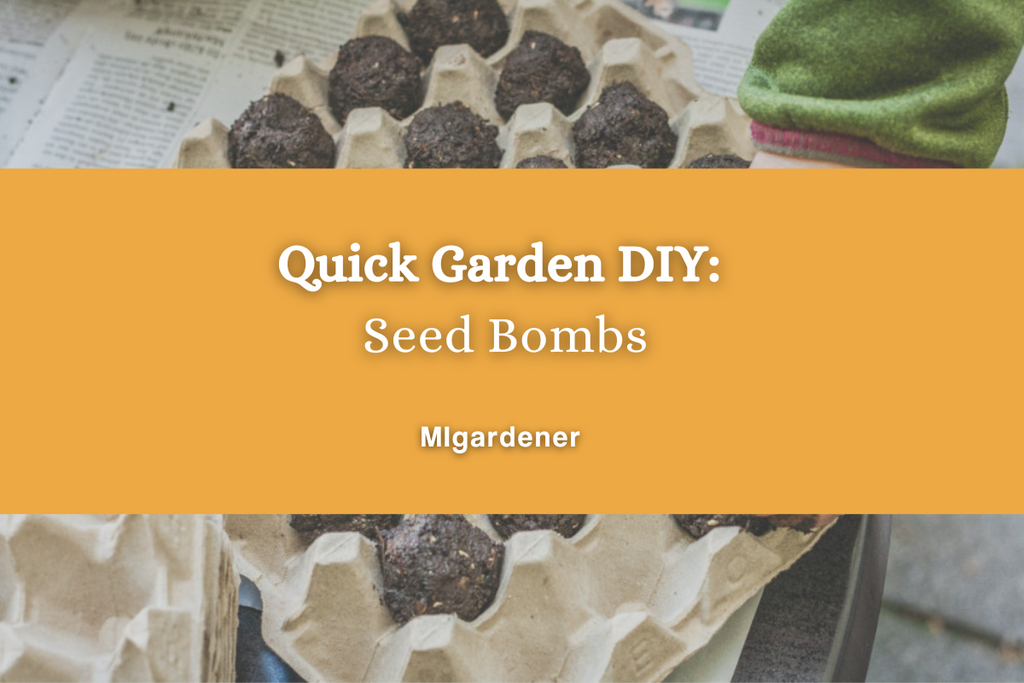
Quick Garden DIY : Seed Bombs
Seed bombs are a fun and eco-friendly way to contribute to greener spaces and promote biodiversity. These small, biodegradable balls are filled with seeds that, when dispersed, can sprout into beautiful plants.
Materials you'll need:
- Clay: You can use clay powder or air-dry clay.
- Compost or potting soil: Ensure it's fertile and suitable for your chosen seeds.
- Seeds: Select native wildflower or herb seeds for best results.
- Water: To moisten the mixture.
- Mixing bowl and spoon.
Steps:
-
Prepare your seeds: Choose seeds that are well-suited to your local climate and ecosystem. Native wildflowers are often a great choice.
-
Mix the ingredients: In a mixing bowl, combine 5 parts clay, 1 part compost or potting soil, and 1-2 parts seeds. Gradually add water while mixing until you have a firm but malleable consistency.
-
Form seed bombs: Roll the mixture into small balls, about 1-2 inches in diameter. Ensure that the seeds are evenly distributed within each bomb.
-
Let them dry: Place the seed bombs on a tray or parchment paper and allow them to dry for 24-48 hours. They should harden and hold their shape.
-
Store or disperse: Once dry, your seed bombs are ready for action. You can store them in a cool, dry place until you're ready to distribute them in gardens, vacant lots, or other suitable locations.
-
Plant your seed bombs: Simply toss the seed bombs onto bare soil, and with rain and time, they will break down, allowing the seeds to germinate and grow into vibrant plants.
Picking The Right Seeds For Your Seed Bombs
When choosing seeds for your seed bombs, it's essential to consider your local climate, soil conditions, and the specific goals you have in mind for the area you plan to disperse them. Here are some recommended varieties for seed bombs:
-
Native Wildflowers: Native wildflowers are always a great choice because they are adapted to your region's climate and soil. Some popular options include:
- Black-eyed Susan
- Bluebonnet (in Texas)
- California Poppy
- Purple Coneflower
- Milkweed (for supporting pollinators and monarch butterflies)
- Lupine
- Coreopsis
-
Herbs: Many herbs are well-suited for seed bombs and can attract beneficial insects or be used in culinary or medicinal purposes. Consider:
- Basil
- Cilantro
- Dill
- Chives
- Lavender
- Mint
- Parsley
-
Butterfly and Bee-Friendly Flowers: To support pollinators, choose flowers that attract butterflies and bees:
- Butterfly milkweed
- Bee balm
- Echinacea (Coneflower)
- Lavender
- Salvia
-
Low-Maintenance Plants: If you're looking for plants that require minimal care, opt for hardy, drought-tolerant varieties like:
- Succulents (e.g., Sedum, Sempervivum)
- California poppy
- Wild bergamot
-
Shade-Tolerant Plants: For areas with partial or full shade, consider shade-tolerant wildflowers such as:
- Columbine
- Ferns
- Hosta
- Wild ginger
-
Native Grasses: Grasses play a crucial role in many ecosystems. Include native grass seeds for added diversity:
- Little Bluestem
- Buffalo Grass
- Switchgrass
- Indian Grass
Creating seed bombs is an easy and enjoyable way to contribute to the environment. Whether you're a gardening enthusiast or a nature lover, these little earth-friendly grenades can make a big difference in supporting local ecosystems. You can even put them in a nice box and gift them, or save them for your next gardening season!
I would like you to add seed saving section to seed bombs. Best times. And cold treatment etc MiGardner is a great site
I’ve been watching your channel on YouTube for years and have learned so much! Just this morning the episode on grow lights I found very help as I have a little orchard in my master bathroom and adding vegetables for the winter. I’m looking forward to making these seed bombs! What a terrific idea also for gift giving. Thank you :))
Leave a comment